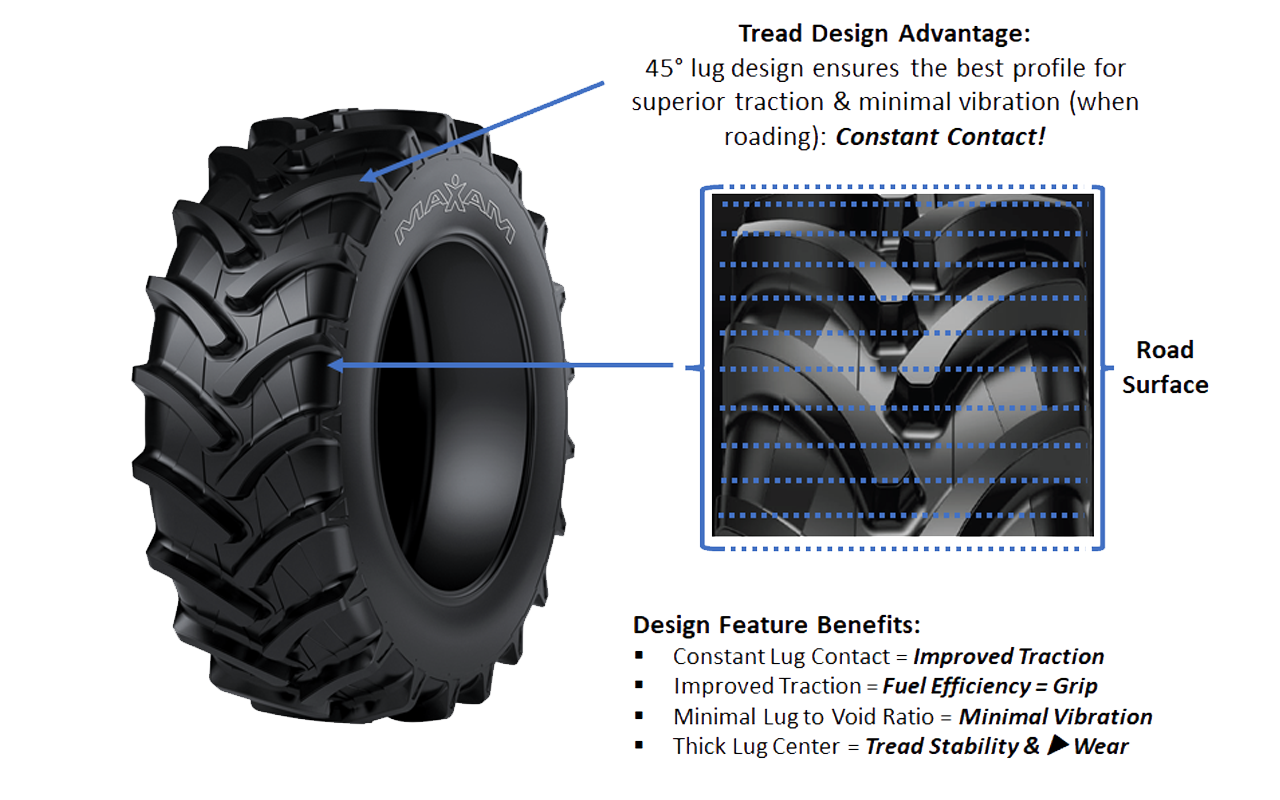MAXAM on the Differences Between a Row Crop Sprayer Tire and a Tractor Tire
AG Technical Bulletin – What is the difference between a Row Crop Sprayer Tire vs Tractor Tire (Void Ratio / Tread Depth / Tread Design / Standard vs VF / Load Speed Index) and why is it important for producer to match the correct tire for the application?
Like all industries, the agricultural market is constantly being driven by the forces of necessity or by the need to improve an existing product to meet evolving demands. Specifically, when we look at the evolution of agricultural tires to the 45° lug design, this technology improvement has been one of the tire industry’s most significant design pillars adopted by all tire manufacturers. The 45° angle tread approach was started in the European market as a solution addressing the lug to void spacing of older tread designs resulting in tire vibration, loss of traction, increased slip, and more fuel consumption when roading or moving tractors from field to field. Comparing tires used in both MFWD or 4 WD Tractors and self-propelled or towed sprayers, the common element inherent to both is the requirement of roading the equipment from operation to operation. From the MAXAM perspective the 45° lug design inherent in all our AGRIXTRA family of products allows us the following features and benefits:

- Self-propelled sprayers will operate both at a slow 5 to 10 mph average in the field and at an average 40 mph when roading from field to field requiring a D rubber compounding.
- Due to heavy tank Loads in cyclic spraying operations, tires must be rated for heavy axle loads in terms of load index or load per tire.
- As sprayers operate when crops are in full bloom and therefore require high crop clearance, the resulting tire sidewall or tire air chamber is smaller which demands stronger structural casing materials and rubber compound designed for high air pressures equal to the load at hand.
- In addition, due to the constant roading of sprayer from field to field, tires designed for this application will have more lugs per tire to reduce the lug to void ratio increasing the amount of rubber contacting the surface ensuring improved stability under load and speed.
As a rule, and considering the above key product requirements that are very different for tractors, harvesters, and floaters vs sprayers, the below table captures the general comparative differences in tires by application:
- R1 – Standard Tread Depth A8 = 25 mph Transport Speed
- R1W – Wet Traction (+20% Deeper Tread) B = 30 mph Transport Speed
- R2 – Super Deep Tread (+40% Deeper Tread) D = 40 mph Transport Speed
| Platform | Tread Type | Lug to Void Ratio | Speed Requirement | Load Capacity |
| MFWD Tractor | R1-R1W-R2 | Standard | A8/B evolving to D | Based on Axle Load |
| 4WD Tractor | R1-R1W-R2 | Standard | A8/B evolving to D | Based on Axle Load |
| Harvestor | R1-R1W-R2 | Standard | A8/B evolving to D | Based on Axle Load |
| Floater | R1-R1W | Standard | D Rated | Based on Axle Load & Speed |
| Self-Propelled Sprayer | R1 | Smaller Void/ ^ Lugs | D Rated | Based on Axle Load & Speed |
As machines are getting larger especially with tractors and harvesters, we are seeing an evolution to “D” rated tires.
At 40 mph sustained road speeds, the shallower R1 tread depth ensures a more uniform distribution of load per lug and reduces irregular treadwear or cupping caused by tire slip when using deep treaded tires at high road torque or speed especially on high clearance self-propelled sprayers.
The advent of VF technology or tires that can carry 40% more load at standard air pressures has allowed high clearance self-propelled sprayer tires the ability to carry the load at reasonable air pressures that can deliver the performance required without compromising soil compaction. In the below example we demonstrate the load capacity of a standard 380/90R46 versus a VF380/90R46:
- Standard 380/90R46 AGRIXTRA N rated at 159A8/B can carry @25/30 mph with a maximum load of 9645 Lbs. at 58 PSI.
- VF380/90R46 AGRIXTRA N rated at 173D can carry @40 mph with a maximum load of 14330 Lbs. at 64 PSI.
- Therefore, at almost the same air pressure the VF tire carries +4600 Lbs. 10 mph faster than the standard tire.
- For a standard tire to carry the 14,000 lbs. you would need to increase the air pressure and slow down the equipment below 30 mph to meet the load.
- In a towed application any Sprayer tire must be inflated to the required axle load or tire load as speed is less of an issue.
- The better the air pressure management, the better the tire performance thus limiting compaction impact to the soil.
MAXAM radial agricultural tractor and sprayer tires have been developed to deliver performance in any working condition worldwide. Our objective is to bring to market radial products in the right sizes, with the right load capabilities, that when operated at the right air pressure will deliver the value and performance our customers expect from MAXAM. Backed by a world-class warranty program, our radial tires are manufactured to maximize performance, reduce compaction, improve traction with superior stability resulting in increased productivity! Try the MAXAM advantage in your operations today!



